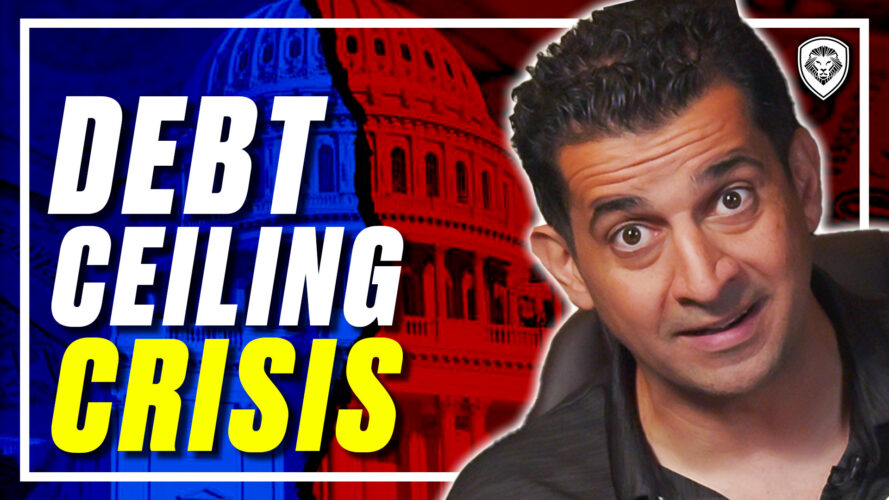Will the U.S. government default on its debt payments for the first time in history? If we do, what does this actually mean?
Six countries have defaulted their debt payments in the last 100 years. Will the greatest nation in the world join in?
First things first — government has access to tools that you and I don’t have. They can manipulate money in ways you and I cannot do. Before we get into levels of manipulation, let’s figure out how the government gets money in the first place. There are two ways: through taxes and through bonds.
- Taxes — Corporate, Individual.
- Bonds we purchase from the government — Treasury bills, T bills, T bonds, short-term, mid-term, long-term.
Learn the benefits of becoming a Valuetainment Member and subscribe today!
Let’s first look at the history of debt ceiling in America. The power to issue money is specifically granted to the U.S. Congress by the constitution. The debt ceiling was established by the second Liberty Bond Act of 1917.
It was not created as a restriction on the federal government’s ability to borrow it — it was created to simplify the process and provide the US treasury with more flexibility in managing the country’s debt.
So pre-1917, the government had to get each line of debt they wanted approved. But this method took too much time.
Then, World War 1 happened — this was a perfect excuse for the government to mention not needing approval every time they need funds but rather get funding through a debt ceiling. This was in an effort to improve and speed up the process — one they’re using as a weapon and point of leverage against each other, which is causing the mayhem that we have today.
Congress has raised, extended or revised the debut ceiling nearly a hundred times since it was established. Congress established the first limits that allowed the U.S. Treasury the ability to issue new debt as long as the total amount outstanding remained under a specified ceiling.
How many times do you think Republicans and Democrats have raised, revised and/or extended the debt limit? Republicans — 49 times. Democrats — 29 times. Why? Because most of the time, when there is a president from one party, the house is controlled by the opposite party. House Democrats are the ones raising the debt ceiling when a Republican has been president, and vice versa. Both sides do it regularly.
Governments that have defaulted:
- Germany (1932 and 1948): Was caused by the inability to repay the reparations imposed after World War I. The default and subsequent economic instability contributed to the rise of the Nazi party.
- Argentina (1951, 1982, 2001, 2014, 2020): The dynasty of defaulting on their government default. Due to unsustainable fiscal policies, economic crisis, and volatile commodity prices, the defaults have resulted in severe economic recessions, high inflation and political instability.
- Russia (1998): Caused by a collapse in confidence in the Russian government’s ability to repay its debt leading to a default. This led to a sharp devaluation of the ruble — a severe economic contraction and political upheaval.
- Greece (2012): Largest sovereign default in history. Causes included structural weaknesses in the Greek economy, misreported government, financial data and the global financial crisis of 2008. This crisis resulted in severe austerity measures high unemployment, a significant contraction, the Greek economy, and a European sovereign debt crisis.
- Venezuela (2017): Venezuelan debt crisis was a result of a drop in oil prices, economic mismanagement and political instability. The country has since experienced hyperinflation, severe shortage of basic goods and a humanitarian crisis.
- Lebanon (2020): Caused by a banking crisis, political instability and civil unrest resulting in severe economic contraction, hyperinflation, and a humanitarian crisis.
What do these countries have in common? Economic mismanagement, political instability, external shocks and unsustainable debt level.
Subscribe to PBD’s YouTube channel today for every episode LIVE or On Demand!
Being that the United States has never once defaulted, will our current political climate be the cause? What’s the difference in America versus these six countries?
- U.S. treasuries are considered the safest and most liquid assets in the world, (Pristine collateral, Tier I asset)
- U.S. plays a crucial role as a collateral and global financial market as they are often used to secure loans, margin accounts, and other financial transactions.
What makes them so pristine, collateral and safe?
- Low credit risk. The US treasuries are backed by the full faith and credit of the US government.
- High liquidity. U.S. treasuries are highly liquid due to their deep and well-established secondary market. This allows market participants to buy and sell those with ease, making them an ideal form of collateral.
- Price stability. U.S. treasuries have relatively stable prices compared to other assets like stocks and commodities. Price stability is advantageous for financial institutions as it reduces the risk of collateral value fluctuations.
- Global acceptance. The U.S. treasuries are widely accepted and used as collateral worldwide providing ease of use for international transactions.
- Repo and reverse repo market. The repurchase agreement market and reverse repo markets is a critical part of the short-term funding and money markets. They facilitate the flow of cash and securities between financial institutions, central banks, and other market participants.
Let’s say we DO default. Here’s what will happen:
- Global financial crisis — A default would cause severe disruptions in global financial markets, as U.S. treasuries are used as the benchmark for other debt securities and as collateral in numerous transactions.
- Economic chaos — Financial markets would be destabilized and the flow of credit would be constrained.
- Currency devaluation — The U.S. Dollar might lose its status as the world’s reserve currency, leading to a depreciation of the currency and increased inflationary pressures.
- Geopolitical implications — A U.S. default could diminish the country’s global influence and potentially alter the balance of power in the international financial system.
- Loss of confidence — A U.S. default would erode global confidence in the country’s ability to honor its obligations, potentially leading to a decline in demand for U.S. treasuries and a rise in borrowing costs for the U.S. government.
- Government shutdown — Without the ability to borrow, the U.S. government would have to cut spending drastically.
- Legal and constitutional — The 14th Amendment to the U.S. Constitution states that the “validity of the public debt shall not be questioned.” So a debt default could potentially trigger a constitutional crisis.
- Impact on credit rating — The U.S. could lose its AAA credit rating, leading to even higher borrowing costs in the future and further damaging the country’s fiscal situation.
Click here to watch this week’s entire Monday Motivational video with PBD!


















Add comment